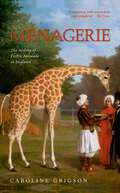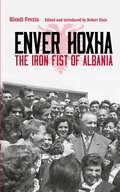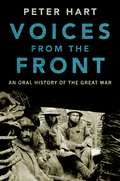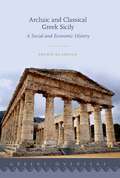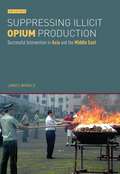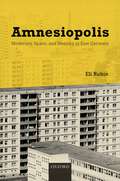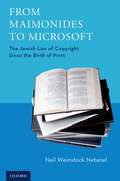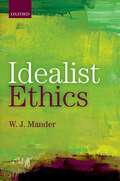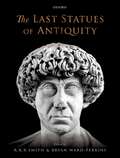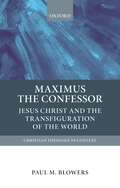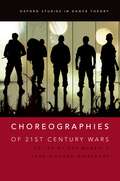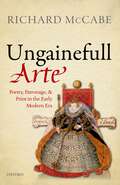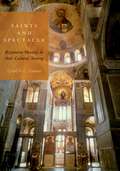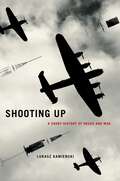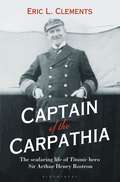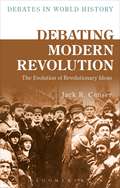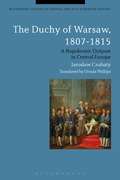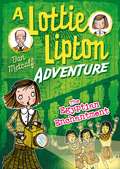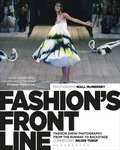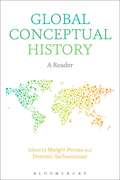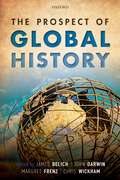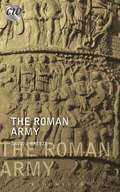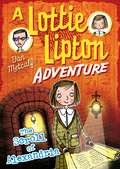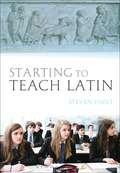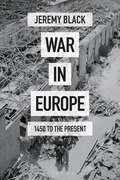- Table View
- List View
Menagerie: The History of Exotic Animals in England
by Caroline GrigsonMenagerie is the story of the panoply of exotic animals that were brought into Britain from time immemorial until the foundation of the London Zoo — a tale replete with the extravagant, the eccentric, and — on occasion — the downright bizarre. From Henry III's elephant at the Tower, to George IV's love affair with Britain's first giraffe and Lady Castlereagh's recalcitrant ostriches, Caroline Grigson's tour through the centuries amounts to the first detailed history of exotic animals in Britain. On the way we encounter a host of fascinating and outlandish creatures, including the first peacocks and popinjays, Thomas More's monkey, James I's cassowaries in St James's Park, and Lord Clive's zebra — which refused to mate with a donkey, until the donkey was painted with stripes. But this is not just the story of the animals themselves. It also the story of all those who came into contact with them: the people who owned them, the merchants who bought and sold them, the seamen who carried them to our shores, the naturalists who wrote about them, the artists who painted them, the itinerant showmen who worked with them, the collectors who collected them. And last but not least, it is about all those who simply came to see and wonder at them, from kings, queens, and nobles to ordinary men, women, and children, often impelled by no more than simple curiosity and a craving for novelty.
Enver Hoxha: The Iron Fist of Albania
by Blendi FevziuStalinism, that particularly brutal phase of the Communist experience, came to an end in most of Europe with the death of Stalin in 1953. However, in one country - Albania - Stalinism survived virtually unscathed until 1990. The regime that the Albanian dictator Enver Hoxha led from 1944 until his death in 1985 was incomparably severe. Such was the reign of terror that no audible voice of opposition or dissent ever arose in the Balkan state and Albania became isolated from the rest of the world and utterly inward-looking. Three decades after his death, the spectre of Hoxha still lingers over the country, yet many people - inside and outside Albania - know little about the man who ruled the country with an iron fist for so many decades. This book provides the first biography of Hoxha available in English. Using unseen documents and first-hand interviews, journalist Blendi Fevziu pieces together the life of a tyrannical ruler in a biography which will be essential reading for anyone interested in Balkan history and communist studies.
Voices from the Front: An Oral History of the Great War
by Peter HartIn the 1980s and early 1990s, Peter Hart, then a young oral historian at the Imperial War Museum in London, conducted 183 interviews with British World War I veterans. After the death of the last veteran in 2009, these interviews have become a rare and invaluable record of the Great War, as remembered by the men who experienced it. The men spoke to Hart of the familiar horrors of the war-poison gas, lice, muddy trenches, newly minted tanks, and sinking ships-enriching each memory with personal anecdote, shedding light on war's effect on soldiers both in wartime and during the years that followed. Hart now returns to these interviews in Voices from the Front. His new book not only provides a narrative timeline of the events of 1914 to 1918, but restores individuality and humanity to the men who were often treated like expendable resources. Hart uses the transcripts of these conversations as a framework on which to build a unique depiction of Britain's experience of the war-one separated from the boastful exaggerations or, alternatively, the underplaying euphemisms often found in letters mailed home or to fellow soldiers. By including the testimonies of men such as William Holbrook, who was just 15 when he enlisted, as well as Harold Bing, an anti-war demonstrator, Hart breathes new life into the experiences of both young soldiers and those who morally opposed the war. The result is history as both narrative and recollection; war experienced first-hand but looked at now from a great distance. Here is an intimate and humanized account of the first great cataclysm of the twentieth century, one endured by the men whose voices we hear in this book, and whose legacies are with us still.
Archaic and Classical Greek Sicily: A Social and Economic History (Greeks Overseas)
by Franco De AngelisAncient Greek migrants in Sicily produced societies and economies that both paralleled and differed from their homeland. Explanations for these similarities and differences have been hotly debated. On the one hand, some scholars have viewed the ancient Greeks as one in a long line of migrants who were shaped by Sicily and its inhabitants. On the other hand, other scholars have argued that the Greeks acted as the main source of innovation and achievement in the culture of ancient Sicily, a culture that was still removed from that of mainland Greece. Neither of these positions is completely satisfactory. What is lacking in this debate is a basic framework for understanding ancient Sicily's social and economic history. Archaic and Classical Greek Sicily represents the first ever systematic and comprehensive attempt to synthesize the historical and archaeological evidence, and to deploy it to test the various historical models proposed over the past two centuries. It adopts an interdisciplinary approach that combines classical and prehistoric studies, texts and material culture, and a variety of methods and theories to put the history of Greek Sicily on a completely new footing. While Sicily and Greece had conjoined histories from the start, their relationship was not one of periphery and center or of colony and state in any sense, but of an interdependent and mutually enriching diaspora. At the same time, local conditions and peoples, including Phoenician migrants, also shaped the evolution of Sicilian Greek societies and economies. This book reveals and explains the similarities and differences between developments in Greek Sicily and the mainland, and brings greater clarity to the parts played by locals and immigrants in ancient Sicily's impressive achievements.
Suppressing Illicit Opium Production: Successful Intervention in Asia and the Middle East
by James WindleConventional analysis of the illicit opium market suggests that source country interventions have at best achieved minimal results. Yet there are countries that have eliminated, or significantly reduced, the illicit production of opium from their territory. Drawing on a wide range of academic, official and non-governmental sources, including previously unidentified records, James Windle provides detailed narratives of countries that have achieved national success, including China, Iran, Turkey, the People s Republic of China, the Islamic Republic of Iran, Thailand, Pakistan, Vietnam and Laos, and identifies key factors necessary for successful intervention. Suppressing Illicit Opium Production makes a valuable contribution to our scarce knowledge of source country drug policy and draws out important lessons to be learned for improving the effectiveness of future interventions. It will be essential reference for all practitioners, policy makers and academics concerned with a subject of significant contemporary relevance."
Amnesiopolis: Modernity, Space, and Memory in East Germany
by Eli RubinAmnesiopolis explores the construction of Marzahn, the largest prefabricated housing project in East Germany, built on the outskirts of East Berlin in the 1970s and 1980s, and touted by the regime as the future of socialism. It focuses particularly on the experience of East Germans who moved, often from crumbling slums left over as a legacy of the nineteenth century, into this radically new place - one defined by pure functionality and rationality - a material manifestation of the utopian promise of socialism. Eli Rubin employs methodologies from critical geography, urban history, architectural history, environmental history, and everyday life history to ask whether their experience was a radical break with their personal pasts and the German past. Amnesiopolis asks: can a dramatic change in spatial and material surroundings sever the links of memory that tie people to their old life narratives, and if so, does that help build a new socialist mentality in the minds of historical subjects? The answer is yes and no-as much as the East German state tried to create a completely new socialist settlement, divorced of any links to the pre-socialist past, the massive construction project uncovered the truth buried-literally-in the ground, which was that the urge to colonize the outskirts of Berlin was not new at all. Furthermore, the construction of a new city out of nothing, using repeating, identical buildings, created a panopticon-like effect, giving the Stasi the possibility of more complete surveillance than they previously had.
From Maimonides to Microsoft: The Jewish Law of Copyright Since the Birth of Print
by Neil Weinstock NetanelJewish copyright law is a rich body of jurisprudence that developed in parallel with modern copyright laws and the book privileges that preceded them. Jewish copyright law owes its origins to a reprinting ban that the Rome rabbinic court issued for three books of Hebrew grammar in 1518. It continues to be applied today, notably in a rabbinic ruling outlawing pirated software, issued at Microsoft's request. In From Maimonides to Microsoft, Professor Netanel traces the historical development of Jewish copyright law by comparing rabbinic reprinting bans with secular and papal book privileges and by relaying the stories of dramatic disputes among publishers of books of Jewish learning and liturgy.. He describes each dispute in its historical context and examines the rabbinic rulings that sought to resolve it. Remarkably, the rabbinic reprinting bans and copyright rulings address some of the same issues that animate copyright jurisprudence today: Is copyright a property right or just a right to receive fair compensation? How long should copyrights last? What purposes does copyright serve? While Jewish copyright law has borrowed from its secular law counterpart at key junctures, it fashions strikingly different answers to those key questions. The story of Jewish copyright law also intertwines with the history of the Jewish book trade and with steadfast efforts of rabbinic leaders to maintain their authority to regulate that trade in the face of the dramatic erosion of Jewish communal autonomy in the eighteenth and nineteenth centuries. This book will thus be of considerable interest to students of Jewish law and history as well as copyright scholars and practitioners.
Idealist Ethics
by W. J. ManderW. J. Mander examines the nature of idealist ethics, that is to say, the form and content of ethical belief most typically adopted by philosophical idealists. While there exist many studies of the ethical views of individual idealist philosophers there has been no literature at all on the notion of idealist ethics per se. Never is it asked: at which points, if any, do the ethical systems of all these thinkers overlap, and what relation, if any, do such commonalities bear to their authors' idealism? Never is the question posed: were you suddenly to become convinced of the truth of some form of philosophical idealism what revisions, if any, would that necessitate in your conception of the truth, nature, and significance of ethical judgements? The inquiry has two aims. The first is historical. From the record of past philosophy, Mander demonstrates that there exists a discernible idealist approach to moral philosophy; a tradition of 'idealist ethics.' He examines its characteristic marks and varieties. The second aim is apologetic. Mander argues that such idealist ethics offers an attractive way of looking at moral questions and that it has much to contribute to contemporary discussion. In particular he argues that Idealist ethics have the power to cut through the sterile opposition between moral realism and moral anti-realism which has come to dominate contemporary thinking about ethical questions. To be an idealist is precisely to hold that the universe is so constituted that things are real if and only if they are ideal; to hold that uncovering in something the work of mind makes it more not less significant.
The Last Statues of Antiquity
Spanning centuries and the vastness of the Roman Empire, The Last Statues of Antiquity is the first comprehensive survey of Roman honorific statues in the public realm in Late Antiquity. Drawn from a major research project and corresponding online database that collates all the available evidence for the 'statue habit' across the Empire from the late third century AD onwards, the volume examines where, how, and why statues were used, and why these important features of urban life began to decline in number before eventually disappearing around AD 600. Adopting a detailed comparative approach, the collection explores variation between different regions-including North Africa, Asia Minor, and the Near East-as well as individual cities, such as Aphrodisias, Athens, Constantinople, and Rome. A number of thematic chapters also consider the different kinds of honorand, from provincial governors and senators, to women and cultural heroes. Richly illustrated, the volume is the definitive resource for studying the phenomenon of late-antique statues. The collection also incorporates extensive references to the project's database, which is freely accessible online.
Maximus the Confessor: Jesus Christ and the Transfiguration of the World (Christian Theology in Context)
by Paul M. BlowersThis study contextualizes the achievement of a strategically crucial figure in Byzantium's turbulent seventh century, the monk and theologian Maximus the Confessor (580-662). Building on newer biographical research and a growing international body of scholarship, as well as on fresh examination of his diverse literary corpus, Paul Blowers develops a profile integrating the two principal initiatives of Maximus's career: first, his reinterpretation of the christocentric economy of creation and salvation as a framework for expounding the spiritual and ascetical life of monastic and non-monastic Christians; and second, his intensifying public involvement in the last phase of the ancient christological debates, the monothelete controversy, wherein Maximus helped lead an East-West coalition against Byzantine imperial attempts doctrinally to limit Jesus Christ to a single (divine) activity and will devoid of properly human volition. Blowers identifies what he terms Maximus's "cosmo-politeian" worldview, a contemplative and ascetical vision of the participation of all created beings in the novel politeia, or reordered existence, inaugurated by Christ's "new theandric energy". Maximus ultimately insinuated his teaching on the christoformity and cruciformity of the human vocation with his rigorous explication of the precise constitution of Christ's own composite person. In outlining this cosmo-politeian theory, Blowers additionally sets forth a "theo-dramatic" reading of Maximus, inspired by Hans Urs von Balthasar, which depicts the motion of creation and history according to the christocentric "plot" or interplay of divine and creaturely freedoms. Blowers also amplifies how Maximus's cumulative achievement challenged imperial ideology in the seventh century—the repercussions of which cost him his life-and how it generated multiple recontextualizations in the later history of theology.
Choreographies of 21st Century Wars (Oxford Studies in Dance Theory)
Wars in this century are radically different from the major conflicts of the 20th century--more amorphous, asymmetrical, globally connected, and unending. Choreographies of 21st Century Wars is the first book to analyze the interface between choreography and wars in this century, a pertinent inquiry since choreography has long been linked to war and military training. The book draws on recent political theory that posits shifts in the kinds of wars occurring since the First and Second World Wars and the Cold War, all of which were wars between major world powers. Given the dominance of today's more indeterminate, asymmetrical, less decisive wars, we ask if choreography, as an organizing structure and knowledge system, might not also need revision in order to reflect on, and intercede in, a globalized world of continuous warfare. In an introduction and sixteen chapters, authors from a number of disciplines investigate how choreography and war in this century impinge on each other. Choreographers write of how they have related to contemporary war in specific works, while other contributors investigate the interconnections between war and choreography through theatrical works, dances, military rituals and drills, the choreography of video war games and television shows. Issues investigated include torture and terror, the status of war refugees, concerns surrounding fighting and peacekeeping soldiers, national identity tied to military training, and more. The anthology is of interest to scholars in dance, performance, theater, and cultural studies, as well as the social sciences.
'Ungainefull Arte': Poetry, Patronage, and Print in the Early Modern Era
by Richard A. McCabeFrom antiquity to the Renaissance the pursuit of patronage was central to the literary career, yet relationships between poets and patrons were commonly conflicted, if not antagonistic, necessitating compromise even as they proffered stability and status. Was it just a matter of speaking lies to power? The present study looks beyond the rhetoric of dedication to examine how traditional modes of literary patronage responded to the challenge of print, as the economies of gift-exchange were forced to compete with those of the marketplace. It demonstrates how awareness of such divergent milieux prompted innovative modes of authorial self-representation, inspired or frustrated the desire for laureation, and promoted the remarkable self-reflexivity of Early Modern verse. By setting English Literature from Caxton to Jonson in the context of the most influential Classical and Italian exemplars it affords a wide comparative context for the reassessment of patronage both as a social practice and a literary theme.
Saints and Spectacle: Byzantine Mosaics in their Cultural Setting
by Carolyn L. ConnorSaints and Spectacle examines the origins and reception of the Middle Byzantine program of mosaic decoration. This complex and colorful system of images covers the walls and vaults of churches with figures and compositions seen against a dazzling gold ground. The surviving eleventh-century churches with their wall and vault mosaics largely intact, Hosios Loukas, Nea Moni and Daphni in Greece, pose the challenge of how, when and where this complex and gloriously conceived system was created. Using an interdisciplinary approach, Connor explores the urban culture and context of church-building in Constantinople, capital of the Byzantine Empire, during the century following the end of Iconoclasm, of around 843 to 950. The application of an innovative frame of reference, through ritual studies, helps recreate the likely scenario in which the medium of mosaics attained its highest potential, in the mosaiced Byzantine church. For mosaics were enlisted to convey a religious and political message that was too nuanced to be expressed in any other way. At a time of revival of learning and the arts, and development of ceremonial practices, the Byzantine emperor and patriarch were united in creating a solution to the problem of consolidating the Greek Orthodox Byzantine Empire. It was through promoting a vision of the unchallengeable authority residing in God and his earthly representative, the emperor. The beliefs and processional practices affirming the protective role of the saints in which the entire city participated, were critical to the reception of this vision by the populace as well as the court. Mosaics were a luxury medium that was ideally situated aesthetically to convey a message at a particularly important historical moment--a brilliant solution to a problem that was to subtly unite an empire for centuries to come. Supported by a wealth of testimony from literary sources, Saints and Spectacle brings the Middle Byzantine church to life as the witness to a compelling and fascinating drama.
Shooting Up: A Short History of Drugs and War
by Lukasz KamienskiShooting Up: A Short History of Drugs and War examines how intoxicants have been put to the service of states, empires and their armies throughout history. Since the beginning of organized combat, armed forces have prescribed drugs to their members for two general purposes: to enhance performance during combat and to counter the trauma of killing and witnessing violence after it is over. Stimulants (e.g. alcohol, cocaine, and amphetamines) have been used to temporarily create better soldiers by that improving stamina, overcoming sleeplessness, eliminating fatigue, and increasing fighting spirit. Downers (e.g. alcohol, opiates, morphine, heroin, marijuana, barbiturates) have also been useful in dealing with the soldier's greatest enemy - shattered nerves. Kamienski's focuses on drugs "prescribed" by military authorities, but also documents the widespread unauthorised consumption by soldiers themselves. Combatants have always treated with various drugs and alcohol, mainly for recreational use and as a reward to themselves for enduring the constant tension of preparing for. Although not officially approved, such "self-medication" is often been quietly tolerated by commanders in so far as it did not affect combat effectiveness. This volume spans the history of combat from the use of opium, coca, and mushrooms in pre-modern warfare to the efforts of modern militaries, during the Cold War in particular, to design psychochemical offensive weapons that can be used to incapacitate rather than to kill the enemy. Along the way, Kamienski provides fascinating coverage of on the European adoption of hashish during Napolean's invasion of Egypt, opium use during the American Civil War, amphetamines in the Third Reich, and the use of narcotics to control child soldiers in the rebel militias of contemporary Africa.
Captain of the Carpathia: The seafaring life of Titanic hero Sir Arthur Henry Rostron
by Eric L. ClementsResponding to Titanic's distress calls in the early hours of 15 April 1912, Captain Arthur Rostron raced the Cunard liner Carpathia to the scene of the sinking, rescued the seven hundred survivors of the world's most famous shipwreck and then carried them to safety at New York. After twenty-five years at sea, the competence and compassion Rostron displayed during the rescue made him a hero on two continents and presaged his subsequent achievements.During the First World War he participated in the invasion of Gallipoli and commanded Cunard's Mauretania as a hospital ship in the Mediterranean and a troop transport in the Atlantic. As her longest-serving master he commanded that legendary vessel in transatlantic passenger service through most of the 1920s. Rostron retired in 1931 as the most esteemed master mariner of his era, celebrated for the Titanic rescue, decorated for his war service, and knighted for his contributions to British seafaring.This account uses newspaper reports, company records, government documents, contemporary publications and memoirs to recount Rostron's seafaring life from his first voyage as an apprentice rounding Cape Horn in sail to his retirement forty-four years later as commodore of the Cunard Line. Set within the context of his times and featuring particulars of the ships in which he served and commanded, this is the first comprehensive biography of Arthur Rostron before, during and after his year as captain of the Carpathia.
Debating Modern Revolution: The Evolution of Revolutionary Ideas (Debates in World History)
by Jack R. CenserRevolution is an idea that has been one of the most important drivers of human activity since its emergence in its modern form in the 18th century. From the American and French revolutionaries who upset a monarchical order that had dominated for over a millennium up to the Arab Spring, this notion continues but has also developed its meanings. Equated with democracy and legal equality at first and surprisingly redefined into its modern meaning, revolution has become a means to create nations, change the social order, and throw out colonial occupiers, and has been labelled as both conservative and reactionary.In this concise introduction to the topic, Jack R. Censer charts the development of these competing ideas and definitions in four chronological sections. Each section includes a debate from protagonists who represent various forms of revolution and counterrevolution, allowing students a firmer grasp on the particular ideas and individuals of each era. This book offers a new approach to the topic of revolution for all students of world history.
The Duchy of Warsaw, 1807-1815: A Napoleonic Outpost in Central Europe (Bloomsbury Studies in Central and East European History)
by Jaroslaw CzubatyThe Duchy of Warsaw, 1807-1815 is the first academic history of the state established by Napoleon in pre-partitioned Poland at the turn of the 19th century. The book examines the political, social and cultural dynamics of the Duchy and considers its role in Napoleon's wider empire and the politics he engaged in across the European continent during the period. Czubaty explores the history of the Duchy to reveal how political and social ideas, systems and mechanisms from France, Italy and Germany began permeating Central Eastern Europe at this time and goes on to consider how this impacted on the changing political mentalities of the Polish people.
The Egyptian Enchantment A Lottie Lipton Adventure (The Lottie Lipton Adventures)
by Dan MetcalfWelcome to the British Museum, home to Lottie Lipton: nine-year-old investigator extraordinaire! Lottie loves helping her Great Uncle Bert with his new exhibits at the British Museum. But when she reads a magic spell that brings to life twenty mischievous Egyptian statues, the museum ends up in a complete mess! Can Lottie, Great Uncle Bert and Reg the caretaker track down the chaotic statues before they destroy the whole museum?Perfect for developing and newly confident middle grade readers, Lottie Lipton Adventures are packed with action, and puzzles for the reader to solve. With a courageous heroine (with a hint of Indiana Jones about her), children will love these historical adventures.
Fashion's Front Line: Fashion Show Photography from the Runway to Backstage
by Nilgin YusufBefore the live streaming of international fashion shows and the instant publication of runway images online, the collections were strictly 'invitation only'. It was the photographer, runway's unsung hero, who allowed us a glimpse of an exclusive and fascinating spectacle. A visual journey through three decades of photographing runway shows in Paris, Milan, London and New York, Fashion's Front Line showcases dazzling images taken by long-serving catwalk photographer Niall McInerney, whose life's work has been painstakingly preserved and made available through Bloomsbury Publishing's Fashion Photography Archive. Giving readers the complete picture, the book captures many rare and never-before-seen images of iconic moments on the runway as well as famous faces on the front row and the buzzing atmosphere backstage. With commentary from the photographer himself, as well as interviews with top international fashion insiders, Fashion's Front Line is a unique window onto the world of late 20th-century fashion. As good as a front row ticket, this book will be a must-have for fashion lovers. Interviewees include: Designer Antony Price; model agent Sarah Doukas; PR and lifestyle guru Lynne Franks; hair stylist Sam McKnight; director of photography Simon Chaudoir; editors and fashion commentators Caryn Franklin, Debbi Mason, Kathryn Samuel, Elizabeth Walker, Brenda Polan and Iain R. Webb; photographers Andrew Lamb, Niall McInerney, Chris Moore, Anthea Simms and Mitchell Sams; set designer and art director Simon Costin; fashion consultant and former show producer Mikel Rosen; show producer John Walford; and digital entrepreneur Jonathan Chippindale.
Global Conceptual History: A Reader
by Margrit Pernau Dominic SachsenmaierThe influential readings contained in this volume combine conceptual history - the history of words and languages - and global history, showing clearly how the two disciplines can benefit from a combined approach. The readings familiarize the reader with conceptual history and its relationship with global history, looking at transfers between nations and languages as well as the ways in which world-views are created and transported through language. Part One: Classical Texts presents the three foundational texts for conceptual history, giving the reader a grasp of the origins of the discipline. Part Two: Challenges focuses on critiques of the approach and explores their ongoing relevance today. Part Three: Translations of Concepts provides examples of conceptual history in practice, via case studies of historical research with a global scope. Finally, the book's concluding essay examines the current state and the future potential of conceptual history. This original introduction provides the students of conceptual, global and intellectual history with a firm grasp of the past trajectories of conceptual history as well as its more recent global and transnational tendencies, and the promises and challenges of writing global history.
The Prospect of Global History
The Prospect of Global History takes a new approach to the study of global history, seeking to apply it, rather than advocate it. The volume seeks perspectives on history from East Asian and Islamic sources as well as European ones, and insists on depth in historical analysis. The Prospect of Global History will speak to those interested in medieval and ancient history as well as modern history. Chapters range from historical sociology to economic history, from medieval to modern times, from European expansion to constitutional history, and from the United States across South Asia to China.
The Roman Army (Classical World)
by David J. BreezeThis authoritative short volume introduces readers to the Roman army, its structure, tactics, duties and development. One of the most successful fighting forces that the world has seen, the Roman army was inherited by the emperor Augustus who re-organized it and established its legions in military bases, many of which survived to the end of the empire. He and subsequent emperors used it as a formidable tool for expansion. Soon, however, the army became fossilized on its frontiers and changed from a mobile fighting force to a primarily defensive body. Written by a leading authority on the Roman army and the frontiers it defended and expanded, this is an invaluable book for students at school and university level, as well as a handy guide for general readers with an interest in military history, the rise and development and fall of the Roman legions, and the ancient world.
The Scroll of Alexandria A Lottie Lipton Adventure (The Lottie Lipton Adventures)
by Dan MetcalfWelcome to the British Museum, home to Lottie Lipton: nine-year-old investigator extraordinaire!Lottie loves the British Museum's Great Library and all the beautiful books that fill it. But the money hungry Head Curator wants to sell all of the ancient books to the highest bider. The missing scroll of Alexandria is the only thing that can prove that the books must stay in the museum. Can Lottie, Great Uncle Bert and Reg the caretaker follow the clues and track down the missing scroll before it's too late?Perfect for developing and newly confident middle grade readers, Lottie Lipton Adventures are packed with action, and puzzles for the reader to solve. Featuring a courageous heroine (with a hint of Indiana Jones about her), children will love these historical adventures.
Starting to Teach Latin
by Steven HuntThis handbook for teachers provides both practical, up-to-date guidance and a theoretical overview on a number of key topics in Latin teaching. Using a wealth of interviews, observations and pupil transcripts, Steven Hunt title utilizes case-study evidence of excellent practice in teaching and learning from a wide variety of institutions: from outreach programmes, community schools and academies in the UK, to New York Charter Schools, KIP schools and schools in Eastern Seaboard states in the USA.Offering practical advice on topics such as essay writing, teaching controversial topics including women, slavery, ethnicity and social hierarchy, making use of primary sources and using ICT to advance language skills, the book also engages with broader questions of approach and theory. These include a survey of the three main approaches to Latin teaching: grammar-translation, communicative and reading approaches; explanation of cognitive and social approaches to learning; and analysis of the differences between intrinsic and extrinsic motivation. Moreover, traditional arguments about the value and purpose of learning Latin at school level are re-examined in the light of current educational thinking and government policy-making.This book is invaluable for trainees, newly qualified teachers and more experienced practitioners looking for practical ideas and strategies to motivate and engage learners of Latin. A companion website www.startingtoteachlatin.org is under construction and will contain a range of resources and information for teachers.
War in Europe: 1450 to the Present
by Jeremy BlackWar in Europe is an overview of war and military development in Europe since 1450, bringing together the work of a renowned historian of modern European and military history in a single authoritative volume. Beginning with the impact of the Reformation and continuing up to the present day, Jeremy Black discusses the following key themes: long-term military developments, notably in the way war is waged and battle conducted the relationship between war and transformations in the European international system the linkage between military requirements and state developments the consequences of these requirements, and of the experience of war, for the nature of societyAdopting a clear chronological approach, Black weaves a rich and detailed narrative of the development of war in relation to transformations in the European international system, demonstrating the links between its causes and consequences in the military, political and social spheres. Assimilating decades of important research as well as bringing new perspectives to the topic, War in Europe is a key text for students taking courses in European history, international relations and war studies.
